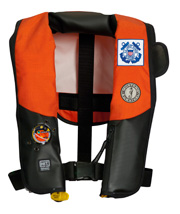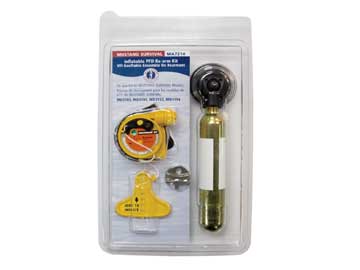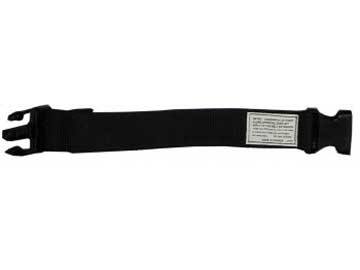Features
- US Coast Guard Auxiliary patch on the left front and USCG Auxiliary on the back flap markings to meet uniform requirements
- Hammar 1F auto hydrostatic inflator is maintenance free for 5 years from date of manufacture unless inflated
- Lightweight and comfortable design
- SecureZip™ closure stays shut in high winds and still opens easily upon inflation
- Neoprene Comfort Collar™ reduces chafing on neck
- Cylinder is contained inside bladder to protect against corrosion
- Durable 420-Denier nylon and heavy duty polyurethane coated nylon
- Strobe light holder, safety whistle and SOLAS reflective tape on bladder
- Reflective shoulder accents
- Bright fluorescent yellow-green inflation cell for improved in-water visibility
- Backup oral inflation tube
- Status indicator window allows user to inspect inflator status
- D-ring for kill switch attachment
- 1½" buckle
- High performance cell with 35 lbs of buoyancy when inflated, is capable of self-righting a facedown person in seconds.
- Re-arm with MA7214 kit
- Leg Strap Assembly MA3032 sold separately
- Belt Extender MA7637 sold separately
Approval: U.S.C.G. - UL1180 - Type V Commercial Use; Type II Recreational Use - Inflatable PFD's 160.076
*Please note: This prosuct is a USCG Type II and USCG Type V Commercial with Type II performance when worn on uninspected commercial vessels less than 40 ft in length and not carrying passengers for hire.
MD3183 34 Size Chart
| |
Chest (inches) |
Weight (lbs) |
Chest (cm) |
Weight (kg) |
| Universal |
30" - 52" |
80lbs. or over |
76 - 132 |
36 kg or over |
Formula to Determine Buoyancy
If a man weighs 200 pounds on land, he only weighs 10 pounds in the water.
80% of the human body is water. Water in the body has no weight in the water.
200 pounds x 80% = 160 pounds
200 pounds – 160 pounds = 40 pounds
The human body is 15% fat, fat is lighter than water.
200 pounds x 15% = 30 pounds
40 pounds – 30 pounds = 10 pounds
A 200 pound person only weighs 10 pounds in the water.
A U.S.C.G. approved Type V vest is mandated to have 17.5 pounds of buoyancy.
If a man weighs 350 pounds on land, he only weighs:
80% of the human body is water. Water in the body has no weight in the water.
350 x 80% = 280 pounds
350 pounds – 280 pounds = 70 pounds
The human body is 15% fat, fat is lighter than water.
350 pounds x 15% = 52.5 pounds
70 pounds – 52.5 pounds = 17.5 pounds
A 350 pound person weighs 17.5 pounds in the water.
Type V PFD
In regards to using Work Vests or any other Life Jacket, the saying goes “It can only save your life if you’re wearing it.” Less obvious is what to expect upon entering the water once you take an unexpected fall. Depending on the height from which you fall, position of your body when entering the water, along with any currents present you may be kep under longer than you think. Type V Vests are required by United States Coast Guard to have a minimum buoyant force of 17 ½ pounds. This is adequate buoyancy to keep your head, neck and the top of your shoulders above the water. You will rise to the surface more quickly with more body fat and air pockets in your clothing. A lean and muscular person will rise more slowly to the surface.
A person of 200 lbs weighs 10 lbs in the water, 80% of a person’s weight is water which has no weight in the water, and about 15% is fat, which is lighter than water, consequently, the real weight of the person in water is about 10 pounds.
Having your Vest fit snugly is key to survival. Loose fitting or unbuckled Vests can slip over your head when falling feet first, allowing you to sink much further down. Hold on to your Vest as you enter the water just in case. Nothing is more important at that moment than getting your mouth above the top of the waves. Once in the water pull your Vest down to make sure all of the buoyancy is under the water. This will get your mouth and nose as high as possible. Most Vests have a strap that goes under your arms to keep your vest from riding up. If it is missing then replacement is recommended. Vests wear out over time and will lose some of their buoyancy. Here’s a quick way to check for the minimum buoyancy of 17 ½ pounds. Attach 20 pounds of steel weight to the Vest. Dumb bell weights work just fine. Twenty pounds of steel weight weighs approximately 17 ½ pounds in the water. If your Vest floats above or just below the surface, it still meets the minimum required buoyancy. If it sinks it should be replaced. The foam in your Vest will lose its buoyancy if it is compressed under weight or crammed in storage. It’s best to hang them or set them on a shelf when not in use.
Humans are land dwellers and need a little help in the water.
Mustang Survival Warranty and Repair Information
**Products not eligible for returns include: Re-Arm Kits, Custom Orders, Non Current and Non Stock Products, Discontinued Products and Inflatable PFD's purchased 6 months ago or longer.
The Mustang Survival Warranty and Repair information sheet is a pdf file. If you are unable to open it you will need to download the latest FREE version of Adobe Acrobat Reader.

Catalogs

2019 Product Guide

2016 Public Safety Catalog

2016 Military Catalog

2016 Product Guide

2016 Range Book
For hard copy catalogs contact us at 763-263-9835. To download, right click the image and select "Save Link As".
The catalogs are pdf files. If you are unable to open it you will need to download the latest FREE version of Adobe Acrobat Reader.

















